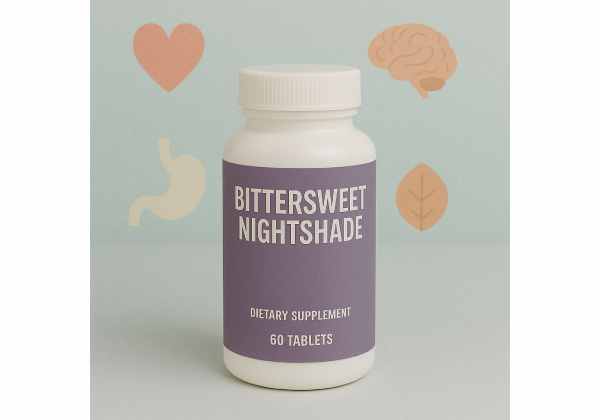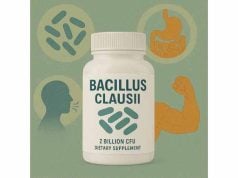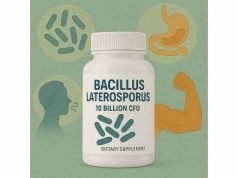
Bittersweet nightshade, also known as Solanum dulcamara, is a climbing perennial vine native to Europe and Asia but now found across North America. Recognized by its distinctive purple flowers and bright red berries, this intriguing plant has a long history in traditional herbal medicine. Herbalists have used bittersweet nightshade to address skin issues, joint pain, respiratory problems, and even as a calming remedy for nerves. However, its use requires caution: all parts of the plant contain alkaloids, which can be toxic if consumed in excess. Today, bittersweet nightshade is sometimes used in topical salves, homeopathic preparations, and carefully controlled herbal formulas. If you’re considering this ancient remedy, understanding its benefits, risks, and best practices is essential for safe and effective use.
Key Takeaways
- Bittersweet nightshade has been used in traditional medicine for skin conditions, joint pain, and mild respiratory issues.
- It contains solanine and related alkaloids, which can be toxic in large amounts—strict dosage control is crucial.
- Most modern use is topical; internal use should only be guided by experienced practitioners.
- Never eat the raw berries or leaves, as toxicity can cause serious health effects.
- Consult a healthcare provider before using bittersweet nightshade, especially if pregnant, nursing, or on medication.
Table of Contents
- Bittersweet Nightshade Plant Profile: History and Traditional Use
- Bittersweet Nightshade’s Bioactive Compounds and Body Effects
- Main Health Benefits and Evidence-Based Applications of Bittersweet Nightshade
- Safety Concerns, Adverse Effects, and Interactions of Bittersweet Nightshade
- Recommended Dosage, Methods, and Administration Guidelines for Bittersweet Nightshade
- Frequently Asked Questions About Bittersweet Nightshade
Bittersweet Nightshade Plant Profile: History and Traditional Use
Bittersweet nightshade (Solanum dulcamara), sometimes called woody nightshade or blue bindweed, is a member of the Solanaceae or nightshade family—home to both well-known foods (like tomatoes and potatoes) and famously toxic plants (such as deadly nightshade). Bittersweet nightshade is most easily identified by its climbing, vining habit, arrow-shaped leaves, violet star-shaped flowers, and clusters of oval, shiny red berries. Its common name comes from the peculiar taste of the root and stem, which is initially bitter, then sweet.
Botanical Description and Habitat
Bittersweet nightshade is a hardy perennial found in moist woodlands, hedgerows, riverbanks, and disturbed soils. Its stems are thin and can reach several meters in length, often twining through other plants or low shrubs. The berries mature from green to bright red and, while visually striking, are toxic if ingested raw.
Traditional European and North American Uses
The use of bittersweet nightshade dates back centuries:
- Ancient and medieval Europe: Used by herbalists for treating skin eruptions (eczema, psoriasis, warts), joint pain, rheumatism, and as a diuretic.
- Native American herbal medicine: Certain tribes used teas and poultices from the root or stem for skin problems and as a mild sedative.
- 19th-century Western medicine: Bittersweet nightshade tinctures and salves were included in official pharmacopoeias as remedies for chronic skin conditions, bronchial complaints, and even “nervous disorders.”
Folk Beliefs and Symbolism
In folklore, bittersweet nightshade was sometimes hung above doorways to ward off evil or used in protective rituals. Its potent reputation as both a healing plant and a poison earned it a place in superstition as well as medicine.
Modern Interest and Research
Today, bittersweet nightshade is rarely used in mainstream herbalism due to its potential toxicity. However, it remains present in some traditional European herbal formulas, homeopathic preparations, and topical products—particularly for skin, joint, or nerve-related complaints. Research interest persists, focusing on its alkaloid content and potential as a source of new bioactive molecules.
How Bittersweet Nightshade Differs from Deadly Nightshade
It’s important not to confuse bittersweet nightshade (Solanum dulcamara) with deadly nightshade (Atropa belladonna). While both are toxic, deadly nightshade contains much higher levels of atropine-like alkaloids and is far more dangerous. Bittersweet nightshade’s risks are mostly due to solanine and similar compounds.
Who Traditionally Used Bittersweet Nightshade?
- Herbalists treating stubborn skin and joint issues
- Folk healers addressing chronic respiratory symptoms
- Individuals seeking natural diuretics or mild sedatives
Understanding this plant’s complex and sometimes contradictory history sets the stage for a deeper look into how and why it was—and in some cases still is—used medicinally.
Bittersweet Nightshade’s Bioactive Compounds and Body Effects
Bittersweet nightshade contains a unique mix of chemicals that contribute to both its healing properties and its potential toxicity. The plant’s effects on the body depend largely on dosage, preparation method, and individual sensitivity.
Key Phytochemicals in Bittersweet Nightshade
- Solanine and related glycoalkaloids: The most significant group, these compounds are found in highest concentration in the berries and unripe plant parts. Solanine is also present in potatoes and other nightshades, but in bittersweet nightshade, it can reach dangerous levels if not carefully managed.
- Dulcamarine: A steroidal alkaloid believed to have mild anti-inflammatory and immune-modulating actions.
- Saponins: Natural surfactants that may help with mucus clearance and mild expectorant activity.
- Flavonoids and phenolic acids: Plant antioxidants with potential to reduce oxidative stress in tissues.
How Bittersweet Nightshade Acts in the Body
- Skin and Connective Tissue:
Topical use (salves or compresses) can reduce itching and inflammation, possibly by modulating immune activity and supporting tissue repair. - Anti-Inflammatory and Rheumatic Action:
Some herbalists use bittersweet nightshade extracts for chronic joint and muscle pain, citing a mild analgesic (pain-relieving) effect. The mechanisms are not fully understood but may involve dampening inflammatory pathways. - Expectorant and Respiratory Support:
Historically, low-dose teas or tinctures have been used for bronchitis, coughs, and mild asthma, believed to help clear mucus and relax the airways. - Mild Nervine (Calming) Effects:
In very small doses, bittersweet nightshade was sometimes prescribed for restlessness or insomnia, possibly due to its alkaloid influence on the nervous system.
Potential Toxic Effects
- Solanine toxicity:
Consuming even moderate amounts can result in gastrointestinal upset (nausea, vomiting, diarrhea), headache, drowsiness, confusion, irregular heartbeat, and in severe cases, paralysis or respiratory failure. - Children and pets:
Especially sensitive to solanine—keep all parts of the plant out of reach.
Modern Scientific Perspective
Contemporary research is cautious but intrigued by bittersweet nightshade. There is active investigation into its glycoalkaloids as potential leads for new anti-inflammatory or antimicrobial drugs, but clinical use is tightly restricted and monitored.
Preparation Methods to Reduce Risk
- Homeopathic dilutions:
Used in some alternative systems; contain extremely low concentrations, generally considered safe. - Topical-only products:
Most modern preparations avoid internal use entirely.
Summary Table: Bittersweet Nightshade’s Actions
| Compound | Effect (Potential) | Risk |
|---|---|---|
| Solanine | Antimicrobial, pain relief, expectorant | Toxicity at low doses |
| Dulcamarine | Mild anti-inflammatory, immunomodulator | Potential allergy |
| Saponins | Expectorant, skin soothing | GI irritation if ingested |
Understanding the dual nature of bittersweet nightshade’s compounds is essential before considering any medicinal use.
Main Health Benefits and Evidence-Based Applications of Bittersweet Nightshade
Despite its dangers, bittersweet nightshade has persisted in traditional medicine because of its noticeable effects in certain conditions—especially when other remedies failed. Today, it is used primarily in highly controlled, often topical, forms. Here are the most commonly cited benefits and their supporting evidence.
1. Skin Conditions: Eczema, Psoriasis, and Chronic Dermatitis
Bittersweet nightshade’s strongest tradition is as a remedy for chronic skin eruptions:
- Historical use: Salves, poultices, and washes made from the stems or root were applied to eczema, psoriasis, warts, and other persistent rashes.
- Modern applications: Select herbal creams or homeopathic preparations still use highly diluted extracts for skin soothing, itch reduction, and to speed healing.
- Scientific perspective: Some anti-inflammatory action is supported by lab research on dulcamarine and flavonoids, but robust clinical trials are lacking.
2. Joint Pain and Musculoskeletal Complaints
- Rheumatism and arthritis: Traditional European herbalists used bittersweet nightshade internally and externally for joint pain, muscle aches, and chronic stiffness.
- How it may help: Possible mechanisms include suppression of local inflammation and modulation of pain pathways.
3. Coughs, Bronchitis, and Mucus Overproduction
- Expectorant effects: Mild saponins in the stem and leaves were believed to loosen mucus and ease coughs, though modern medicine favors safer alternatives.
4. Nervous System Calming and Sleep Aid
- Restlessness, anxiety, insomnia: In tiny doses, bittersweet nightshade was once prescribed for calming the nerves, possibly due to its alkaloid content.
- Current status: Internal use is not recommended outside the guidance of a skilled practitioner due to safety concerns.
5. Potential Antimicrobial Effects
- Laboratory studies: Some extracts show activity against bacteria and fungi, but these findings have not yet led to safe, effective human therapies.
Who Might Benefit from Bittersweet Nightshade?
- Adults with chronic, non-healing skin issues (topical use only, under expert supervision)
- Individuals interested in traditional homeopathic remedies for skin or respiratory complaints
- Rarely, those seeking plant-based alternatives for stubborn musculoskeletal or nerve discomfort, but only under professional care
Important Limitations and Warnings
- No self-treatment: Do not self-medicate with bittersweet nightshade, especially internally.
- Lack of high-quality human research: Most uses are based on tradition, small case series, or laboratory studies.
- Topical and homeopathic use is considered safest, but even these should be approached with care.
Popular Modern Forms and Uses
- Homeopathic pellets: Used for skin and joint complaints, usually safe due to extreme dilution.
- Herbal creams or salves: For skin eruptions and itchiness.
- Traditional tinctures: Now rare and should never be used without professional guidance.
Bittersweet nightshade remains a plant of intrigue—respected for its power but respected even more for its risk.
Safety Concerns, Adverse Effects, and Interactions of Bittersweet Nightshade
Bittersweet nightshade’s powerful properties come with equally potent risks. Understanding the plant’s toxicity, the symptoms of overdose, and its possible interactions with medications or health conditions is vital for anyone considering its use—even in topical or homeopathic forms.
Toxic Components: Solanine and Glycoalkaloids
All parts of bittersweet nightshade—especially the berries and unripe leaves—contain glycoalkaloids such as solanine and dulcamarine. While small doses are sometimes used in traditional medicine, these compounds can quickly become dangerous if not properly managed.
Symptoms of Bittersweet Nightshade Poisoning
- Gastrointestinal effects: Nausea, vomiting, stomach cramps, diarrhea, and abdominal pain are the most common signs, often occurring within a few hours of ingestion.
- Neurological symptoms: Headache, dizziness, confusion, drowsiness, hallucinations, and, in severe cases, tremors, seizures, or paralysis.
- Cardiovascular risks: Irregular heartbeat, lowered blood pressure, or, rarely, respiratory distress.
- Skin contact: Topical use of concentrated extracts may cause irritation, redness, or allergic reactions in sensitive individuals.
Populations at Higher Risk
- Children and pets: Even small amounts can cause severe, sometimes life-threatening symptoms. Keep all plant parts, extracts, and preparations far from children and animals.
- Pregnant or breastfeeding women: Avoid use altogether; the effects on fetal and infant health are unknown and potentially harmful.
- Individuals with chronic illness: Those with heart, kidney, or liver conditions may be more susceptible to toxic effects or adverse interactions.
Potential Drug Interactions
Bittersweet nightshade may interact with:
- Sedatives or anti-seizure medications: Glycoalkaloids can intensify nervous system effects, possibly increasing drowsiness or lowering the seizure threshold.
- Cardiovascular drugs: Risk of abnormal heart rhythm or blood pressure changes.
- Immunosuppressants: Some constituents can influence immune system activity; avoid combining without professional oversight.
- Other nightshade-family foods or herbs: Cumulative intake of glycoalkaloids (from potatoes, tomatoes, eggplants) can raise toxicity risk.
Safe Use Principles
- Never consume raw berries or leaves. Even small amounts can be toxic.
- Avoid internal use unless prescribed and monitored by a knowledgeable herbalist or integrative physician. Internal tinctures or teas are rarely recommended in modern practice.
- For topical products: Perform a patch test first. Apply a small amount to clean skin and wait 24 hours to check for redness or irritation.
- Homeopathic forms: While generally safe due to high dilution, only use those prepared by reputable companies.
- Discontinue use immediately if you experience any adverse reactions, and seek medical help for symptoms of poisoning.
Signs of Allergic Reaction
Some individuals may be hypersensitive, developing:
- Rash, hives, or itching
- Swelling of lips, face, or throat
- Difficulty breathing
These symptoms require urgent medical attention.
Handling and Storage
- Store all bittersweet nightshade products—creams, homeopathic pellets, dried stems—out of reach of children and pets.
- Wear gloves when handling the fresh plant, especially if you have sensitive skin or open cuts.
Legal and Regulatory Status
Bittersweet nightshade is restricted or banned for medicinal use in several countries due to its potential toxicity. Always check local regulations before purchasing or using products containing this plant.
Summary Table: Bittersweet Nightshade Safety
| Scenario/Group | Safe Use? | Notes |
|---|---|---|
| Children/pets | Never | Extreme risk of toxicity |
| Pregnant/nursing women | Never | Unknown, potentially harmful effects |
| Internal (oral) use | Only with Rx | Requires medical or herbalist supervision |
| Topical use (diluted) | With caution | Test on small area, monitor for reaction |
| Homeopathic pellets | Generally safe | Use reputable products, proper dilution |
By treating bittersweet nightshade with utmost caution and respect, you can reduce the risk of serious health effects.
Recommended Dosage, Methods, and Administration Guidelines for Bittersweet Nightshade
Bittersweet nightshade is not a supplement for casual or self-directed use. Dosing must be exact and is often much lower than with most herbs due to its potent alkaloids. Here’s what you need to know about safe administration.
Topical Use (Most Common and Safest Method)
- Salves, ointments, and creams: Only use products made with professionally extracted and diluted bittersweet nightshade. Apply sparingly to affected skin areas, not more than 2–3 times daily.
- Poultices or compresses: Prepared with dried stem or root, used for stubborn rashes or joint discomfort, always under the guidance of an herbalist.
Homeopathic Preparations
- Pellets/tablets: Typical potencies are 6C to 30C, with dosing instructions from the manufacturer or homeopath. Homeopathic remedies contain very little to no active alkaloid.
- Liquids: Use as directed by a homeopath, often several drops diluted in water.
Internal (Oral) Use—Extremely Rare
- Tinctures or teas: If prescribed, dosing is usually just a few drops of tincture diluted in water, once or twice daily for short periods only. Never attempt this without expert supervision.
General Administration Guidelines
- Start with the smallest effective dose: For topical use, apply a small amount first and monitor for reaction.
- Never increase the dose: More is not better with bittersweet nightshade—higher doses sharply increase toxicity risk.
- Cycle use: Prolonged daily use is not recommended. Most protocols use it for acute flare-ups, then stop.
- Do not apply to broken or irritated skin: This increases risk of absorption and toxicity.
Signs You Need to Stop Immediately
- Sudden skin irritation, redness, swelling, or blistering after topical use
- Any signs of poisoning (GI distress, confusion, dizziness) after accidental ingestion
- Worsening of the original condition or development of new symptoms
Choosing Quality Products
- Purchase only from established, reputable brands with clear labeling and safety testing.
- Avoid DIY preparations unless you are highly experienced and have proper botanical identification.
Storage and Disposal
- Store products in a cool, dry place out of direct sunlight.
- Dispose of unused raw plant material safely to prevent accidental poisoning.
What to Do in Case of Suspected Poisoning
- Call poison control or emergency services immediately.
- Bring the product or plant sample to help identify the exposure.
By respecting these strict guidelines, bittersweet nightshade can be used in select cases as a traditional remedy—always with safety as the first priority.
Frequently Asked Questions About Bittersweet Nightshade
What is bittersweet nightshade used for in herbal medicine?
Primarily for chronic skin issues like eczema or warts, and occasionally for joint pain or coughs—mostly as a topical or homeopathic remedy. Internal use is now rare due to safety concerns.
Is bittersweet nightshade poisonous?
Yes. All parts, especially the berries and leaves, contain toxic alkaloids. Never eat raw plant parts and only use professionally prepared remedies under expert guidance.
Can bittersweet nightshade be used safely?
Safe topical or homeopathic use is possible with professionally prepared products and appropriate dosing. Never attempt to self-treat with the raw plant.
What are the symptoms of bittersweet nightshade poisoning?
Gastrointestinal distress (nausea, vomiting), confusion, drowsiness, headache, irregular heartbeat, and in severe cases, seizures or respiratory problems.
Are there any drug interactions with bittersweet nightshade?
Yes. It may interact with sedatives, cardiovascular medications, or immunosuppressants. Always consult your healthcare provider before use.
Is it safe during pregnancy or breastfeeding?
No. Bittersweet nightshade should be strictly avoided during pregnancy and breastfeeding.
How should bittersweet nightshade products be stored?
Keep all preparations away from children and pets, in a cool, dry place, and never within reach of those at risk for accidental ingestion.
Disclaimer:
This article is for educational purposes only and does not replace medical advice. Bittersweet nightshade is a potent plant with toxic risks—never self-treat or ingest raw plant parts. Consult a healthcare provider before using any form of this supplement, especially if you are pregnant, breastfeeding, taking medications, or have underlying health issues.
If you found this guide helpful, please share it on Facebook, X (formerly Twitter), or your favorite platform, and follow us for more science-backed herbal insights. Your support helps us keep creating trustworthy content for the wellness community!










